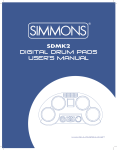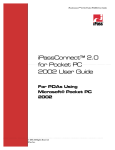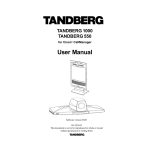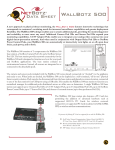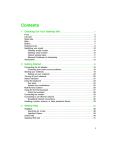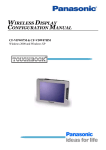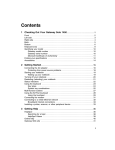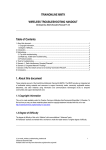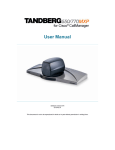Download Casio Watch 1933 User's Manual
Transcript
Module No.1856/1933 1856/1933-1 GENERAL GUIDE • Press C to change from mode to mode. • In the Timekeeping Mode, press D to illuminate the display for about 3 seconds. In the Stopwatch Mode, press B to illuminate the display. Timekeeping Mode Mix Mode Alarm Mode Stopwatch Mode TIMEKEEPING MODE ALARM MODE • In the Timekeeping Mode, press E to switch between the 12-hour and 24-hour formats. When using the 12PM indicator Month – Day hour timekeeping format, the letters A and P are used to indicate “am” and “pm” on the display. No indicator appears on display for 24-hour format. • Press D in the Timekeeping Mode to activate the EL backlight. • Pressing B in the Timekeeping Mode randomly selects and plays one of the six melodies (three preset melodies, three user melodies) in watch memory. While a melody is playing, dancers and musicians perform on the display. Pressing any button interrupts play of the melody. Hour Seconds • See the “Melody List” at the back of this manual for details on the three preset melodies. Minutes Individual alarm on indicator You can set five independent alarms. Use the Alarm Mode Day of week to turn the alarm and the Hourly Time Signal on and off. • When an alarm is turned on, an alarm tone sounds for about 10 to 30 seconds when the alarm time is reached. • When the Hourly Time Signal is turned on, the watch beeps every hour on the hour. • You can use any of the preset melodies (M-1, M-2, M3) or melodies you arrange with the Mix Mode for the alarm in place of the standard beep sound. See “USING THE MIX MODE” for details on arranging your own melodies. • See the “Melody List” on the next page of this manual for details on the three preset melodies. • The alarm does not sound if the alarm time is reached while you are arranging a melody in the Mix Mode. Mode indicator Current time Alarm time Alarm number General alarm on indicator To set the time and date To set alarms 1. Hold down A while in the Timekeeping Mode. The seconds digits flash on the display because they are selected. 2. Press C to change the selection in the following sequence. E while in the Alarm Mode to select an alarm Individual alarm on indicator 1. Press Seconds Hour Minutes Year Day Month (Alarm 1 through Alarm 5). Alarm sound name Alarm 1 Current time Alarm 2 Alarm 3 Alarm 5 Hourly Time Signal Contrast 3. While the seconds digits are selected (flashing), press E or B to reset the seconds to 00. If you press E or B while the seconds count is in the range of 30 to 59, the seconds are reset to 00 and 1 is added to the minutes. If the seconds count is in the range of 00 to 29 , the minutes count is unchanged. 4. While any other digits (besides seconds) are selected (flashing), press E to increase the number or B to decrease it. Holding down either button changes the current selection at high speed. • Use the contrast adjustment screen (indicated by “CNT”) to adjust display contrast within a range of 1 to 7. Press E to increase the contrast value (which makes figures darker) or B to decrease the value. In the case of contrast setting, holding either button does not change the contrast setting at high speed. 5. After you set the time and date, press A to return to the Timekeeping Mode. • The day of week is automatically set in accordance with the date. • The date can be set within the range of January 1, 1995 to December 31, 2039. • If you do not operate any button for a few minutes while a selection is flashing, the flashing stops and the watch goes back to the Timekeeping Mode automatically. About the backlight In the Timekeeping Mode, press D to illuminate the display for about 3 seconds. In Stopwatch Mode, press B to illuminate the display for about 3 seconds. • The backlight of the watch employs an electro-luminescent (EL) light, which loses illuminating power after very long use. • The illumination provided by the backlight may be hard to see when viewed under direct sunlight. • The watch will emit an audible sound whenever the display is illuminated. This is caused by a transformer that vibrates when the EL panel lights up. It does not indicate malfunction of the watch. • The backlight automatically turns off whenever an alarm sounds. Alarm 4 2. After you select an alarm, hold down A . The alarm sound name flashes on the display because it is selected. • At this time, the alarm is automatically switched on. 3. Press C to change the selection in the following sequence. Alarm time Alarm sound name Alarm number Hour Minutes General alarm on indicator 4. Press E to increase the selected digits and B to decrease them. Holding down either button changes the selection at high speed. • The format (12-hour and 24-hour) of the alarm time matches the format you select for normal timekeeping. • When setting the alarm time using the 12-hour format, take care to set the time correctly as morning (A) or afternoon (P). 5. While the alarm sound name is flashing, press E or B to scroll through the available alarm sounds to find the one you want. M-1 M-2 003 BEEP M-3 002 001 • Melody numbers, 001 through 003 can be replaced by user melody names. If you have not created your own melodies or if you did not assign names to melodies you created, melodies are identified by their numbers 001 through 003. 6. After you finish inputting data, press A to return to the Alarm Mode. • If you do not operate any button for a few minutes while a selection is flashing, the flashing stops and the watch goes back to the Alarm Mode automatically. To stop the alarm Press any button to stop an alarm when it starts to sound. MIX MODE The Mix Mode lets you arrange your own melody and store it in watch memory. You can select a rhythm, tempo, and phrase to create a melody. See “USING THE MIX MODE” for details about how to create a melody. To switch an Alarm on and off Individual alarm on indicator ......... Individual alarm indicator Indicates whether the alarm whose number is currently selected in the Alarm Mode is on. To play a Mix Mode melody 1. Use the E button to select one of the three available melodies. 2. Press D to play the currently selected melody. Pressing any button interrupts play of the melody. • While a melody is playing, dancers and musicians perform on the display. • If the melody number you select above does not have a user memory assigned to it, a default rhythm pattern plays instead. • Pressing B while a melody is selected (but not playing) displays the melody evaluation screen for the melody. Melody number See “USING MIX MODE” for details on evaluating melodies. • Holding down B for about two seconds while a melody is selected (but not playing) deletes the melody. 1. In the Alarm Mode, press E to select an alarm. 2. When the alarm you want is selected, press B to switch it on and off. Title Alarm time Alarm number General alarm on indicator ALM ....... General alarm indicator This indicator is shown on the display in all modes while any alarm is on. 1856/1933-2 To turn Hourly Time Signal on and off 1. In the Alarm Mode, press E to select the Hourly Time Signal. 2. When the Hourly Time Signal is selected, press B to Current time toggle it on (ON appears in lower part of the display) and off (OFF displayed). Hourly time signal on indicator 1 ......... Hourly Time Signal Indicator 1 This indicator is shown in the Alarm Mode only to indicate that the Hourly Time Signal is on. SIG ........ Hourly Time Signal Indicator 2 This indicator is shown on the display in all modes while the Hourly Time Signal is on. Hourly time signal on indicator 2 Hourly time signal on/off display To test the alarm Press D while in the Alarm Mode to sound the alarm. Press any button to stop the alarm. STOPWATCH MODE Mode indicator Hours The Stopwatch Mode lets you measure elapsed time, split times, and two finishes. The range of the stopwatch is 23 hours, 59 minutes, 59.99 seconds. You can use the EL backlight by pressing B at any time while the stopwatch is operating. Minutes Seconds 1/100 Second Elapsed time measurement Start Stop Re-start Stop Clear Split release Stop Clear Split Stop Split release Clear First runner finishes. Second runner finishes. Record time of first runner. Record time of second runner. Split time measurement Start Split Split time and 1st-2nd place times Start MELODY LIST 1856 M-1 HIGH ENERGY PROTONS M-2 FEEL THE UNIVERSE M-3 FREAK All of these are CASIO original melodies. 1933 M-1 New year’s day M-2 Orinoco flow M-3 Runaway T-9890248 1856/1933-3 USING THE MIX MODE Selecting a Melody Number Selecting a Phrase Selecting a Rhythm and Tempo Press C Press D Press C Hold down A Insert Phrases Assign a title Press D Press A Press C no operation for a few minutes The above illustration shows the general flow of the Mix Mode only. Note that you will also have to press other keys in addition to those noted above. The Mix Mode lets you arrange your own melody and store it in watch memory. You can select a rhythm, tempo and phrase to create a melody eight measures long. Number 01 02 03 04 05 06 07 08 Phrase Measure Measure Measure Measure Measure Measure Measure Rhythm Measure 1 2 3 4 5 6 7 8 • You can arrange a melody using the watch’s pre-programmed rhythms and phrases only. You cannot input your own melodies. After you arrange a melody, you can play it back in the Mix Mode or use it for an alarm sound. • In the Timekeeping Mode, press C to enter the Mix Mode. Melody name Melody number Melody Number Melody Name Rhythm Number Rhythm Name Tempo Value P-1 P-2 Phrases Assign P-3 P-4 001 001 01 16 beat 120 Electric guitar Trumpet Maracas Cymbal 002 002 02 New jack swing 190 Trumpet Marimba Bell Cymbal 003 003 03 Mambo 110 Violin Accordion Timbales Piano Number 09 10 11 12 13 14 15 16 Rhythm Name Country Swing House R&B Soul Oriental Hip hop Techno • Pressing D plays a sample of the currently displayed rhythm. Press any button to interrupt play of a rhythm. 3. After setting the rhythm, press E to cycle through the available tempo values in the sequence shown below. 60 • The following shows the default rhythm patterns that are assigned to each melody number. These patterns are automatically restored whenever you delete the melody. Rhythm Name 16 beat New jack swing Mambo Rock Bossa nova Ballad Samba Reggae 70 200 80 190 90 180 100 170 110 160 120 150 130 140 • The initial tempo setting is the one that is recommended for the currently selected rhythm. • Pressing D plays a sample of the currently selected rhythm and tempo. Press any button to interrupt play of a rhythm. Selecting a Phrase Phrase mark Button marks While rhythm and tempo selection screen is on the display, press C to display the phrase selection screen. You can assign one of 10 musical phrases each to buttons B, C, D and E. A button mark (flashing) and the phrase mark on the display shows which phrase is assigned to which button. General Procedure The following are the general steps for arranging a melody in the Mix Mode. Details for each step are provided in the following sections. 1. Select a melody number (001~003). 쒆 쒆 쒆 쒆 2. Select a rhythm and tempo that you want to use as a basis for your melody. 3. Assign phrases to each button. Button position number The following table shows the meaning of each phrase mark. 4. Insert phrases by pressing buttons in accordance with the rhythm. Instrument Phrase Mark 5. Assign a melody name to the completed melody. Important! If you do not perform any button operation for a few minutes while arranging a melody, the watch automatically returns from the input screen to the standard Mix Mode screen. If this happens, restart from step 1 of the General Procedure. Selecting a Melody Number There are three melody memory areas numbered 001, 002 and 003. Press E to select the memory area where you want to store the melody you will arrange. 001 002 003 • Until you input your own melody name, the default melody name is the same as the melody number. • Selecting a melody number that already has a melody assigned to it and inputting a new melody causes the existing melody to be replaced by the new one. • Pressing D while the melody number that already has a melody assigned to it is on the display plays back the melody. Press any button to interrupt melody playback. • Pressing B while the melody number that already has a melody assigned to it is on the display displays an evaluation of the melody. See “Mixing a Melody” below for details. • Holding down B for about two seconds while a melody number that already has a melody assigned to it is on the display deletes the melody and restores the melody number’s default pattern. Selecting a Rhythm and Tempo Rhythm number Select a rhythm and tempo that you want to use as a basis for your melody. 1. Hold down A until the rhythm selection screen appears. • The indicators “REC” and “TEMPO” appear on the display. 2. Press B to advance to the next rhythm number. The following table shows the meaning of each rhythm number. Phrase Mark Instrument Electric guitar Bell Timbales Cymbal Trumpet Violin Piano Accordion Maracas Marimba • Each phrase is written in a style that is representative of its phrase mark instrument. To assign a phrase to a button P-1 P-2 P-4 1. Use E to select the button to which you want to assign the phrase. 2. Use B to select a phrase. • Repeat steps 1 and 2 to assign phrases to all four buttons. • Pressing D plays a sample of the currently selected phrase. Press any button to interrupt play of a phrase. P-3 Mixing a Melody Tempo value [Standby screen] Melody number Use the following procedure to play phrases in time with the rhythm you selected to arrange the melody you want. The melody stops automatically after eight measures. 1. When the phrase assignment screen is on the display, press C to display the Mix Mode standby screen. • Pressing C again returns to the rhythm and tempo setting screen. • Holding down B at this time displays the numbers of the currently selected rhythm and tempo. • Pressing E at this time displays the MUTE indicator, which means that output is muted. While MUTE is on the display, you can arrange your melody without outputting any sound. Press E again to clear the MUTE indicator and unmute the output. 1856/1933-4 2. Press D. This causes a four-beat count to sound and then starts the mixer. 3. Insert phrases by pressing B , E, D and C in accordance with the rhythm. • During the above mixing procedure, the left side of the upper display shows the instrument for the phrase that is assigned to each button you press. The right side of the upper display shows random animations of musicians. Tempo value Measure A 11-level evaluation screen appears after you finish inputting the phrase. The following table shows the display indicator for each evaluation point range. Point Range 10 5 to 9 Display Indicator bar graph flashes 9 8 67 5 5 6 7 8 9 1 0 to 4 4 3 2 1 2 3 4 • Press B if you want to view the evaluation again. Evaluating a Melody After you mix an melody, you can evaluate it and decide whether or not you want to keep it. To accept a melody and assign it a name 1. While the OK message is on the display after you finish arranging a melody under “Mixing a Melody”, press D to accept the melody and display the name assignment screen. • This displays the name input screen, with a character input cursor flashing at the far left. You can input up to three characters for a melody name. 2. Use E and B to scroll forward and back through characters at the current cursor position. Press 0 to 9 (Space) A to Z Press 3. When the character you want is at the cursor position, press C to move the cursor to the right. • Repeat steps 2 and 3 to input the other two characters. 4. After the melody name is the way you want it, press A to store the melody and its melody name in memory, and return to the normal Mix Mode screen. • After you arrange a melody, you can play it back in the Mix Mode or Timekeeping Mode, and you can use it for an alarm sound. • Pressing A before OK appears on the display aborts the procedure without saving anything. • Pressing A while OK is on the display stores the melody with the name currently assigned to the melody number. • Not performing any operation for two or three minutes while OK message is on the display stores the melody with the name currently assigned to the melody number. • You can assign a name to a melody only immediately after arranging the melody. You cannot change the melody name only without changing the melody itself. To reject a melody 1. While the OK message is on the display after you finish arranging a melody under “Mixing a Melody”, press E to reject the melody. At this time, the message NG appears on the display. 2. Press D . At this time, the message RETRY appears on the display. 3. Next, the rhythm and tempo selection screen appears, so you can try arranging the melody again. To delete the melody • Holding down B for about two seconds while a melody number that already has a melody assigned to it is on the display deletes the melody and restores the melody number’s default pattern.




